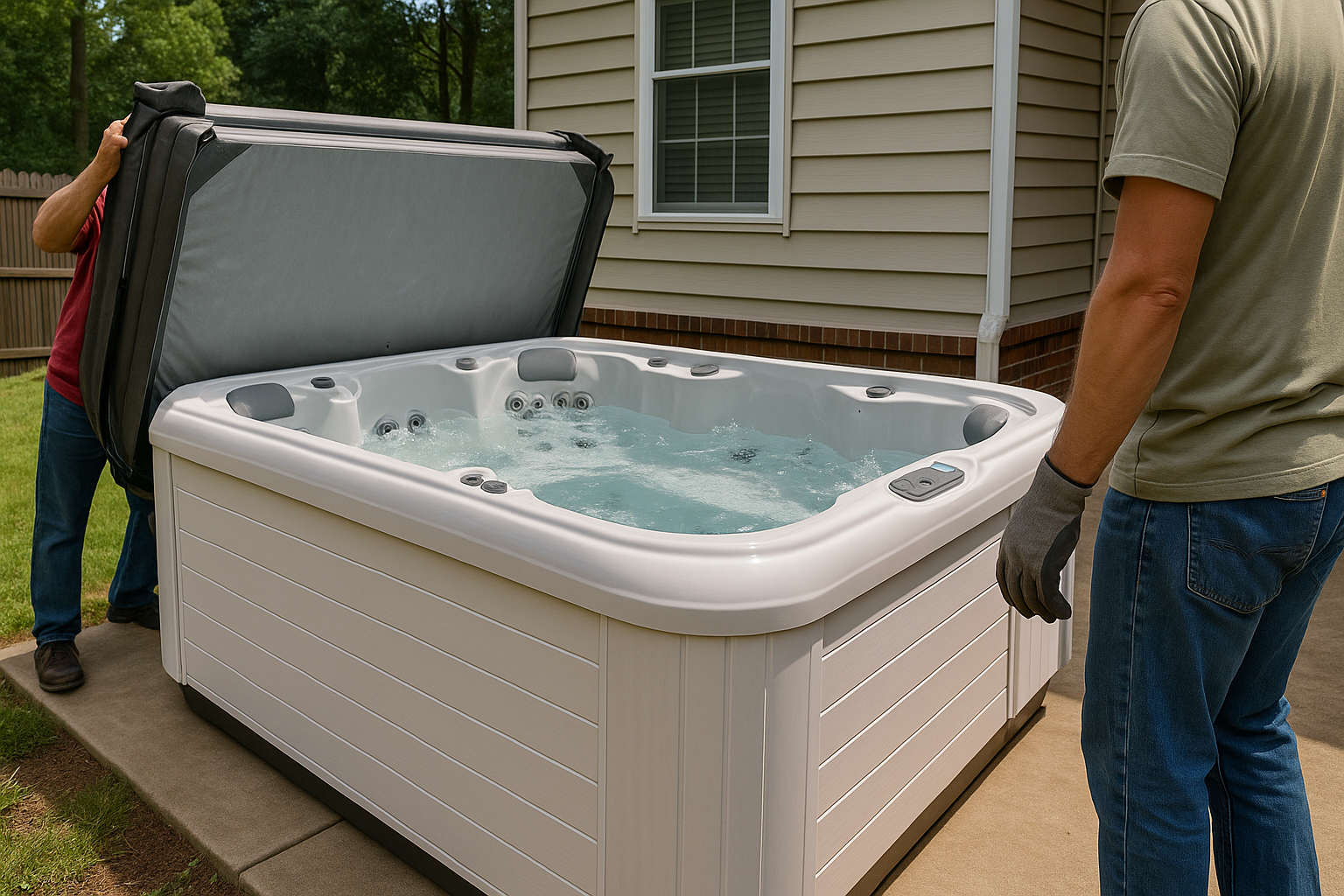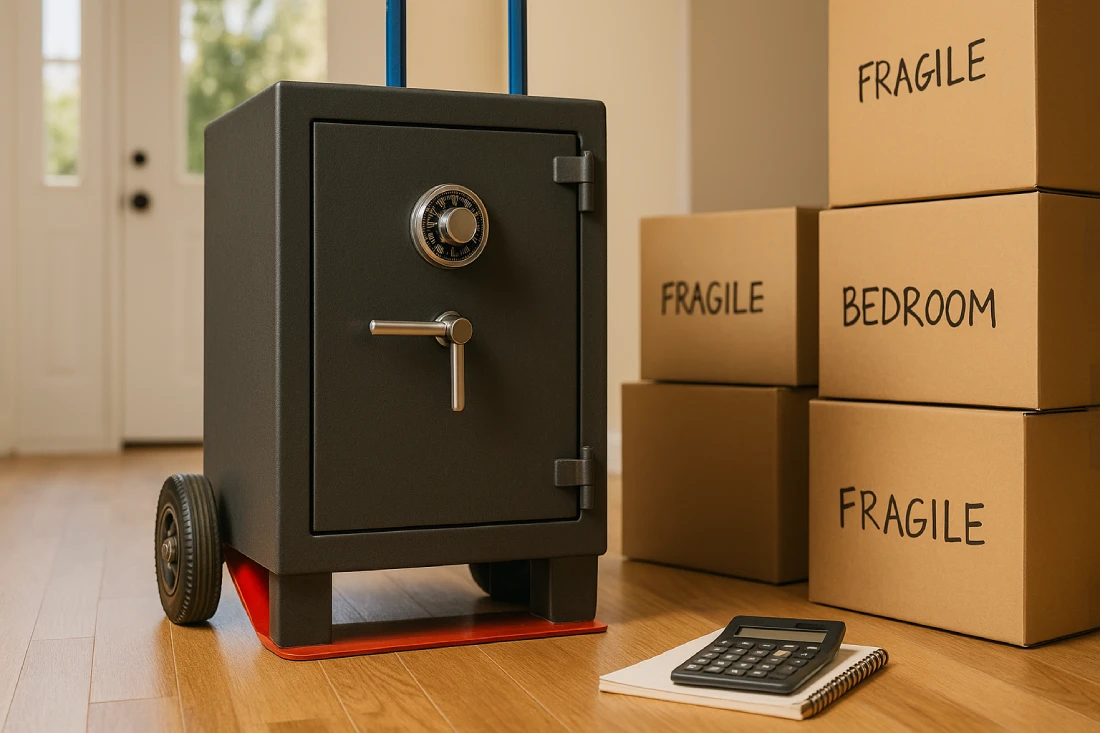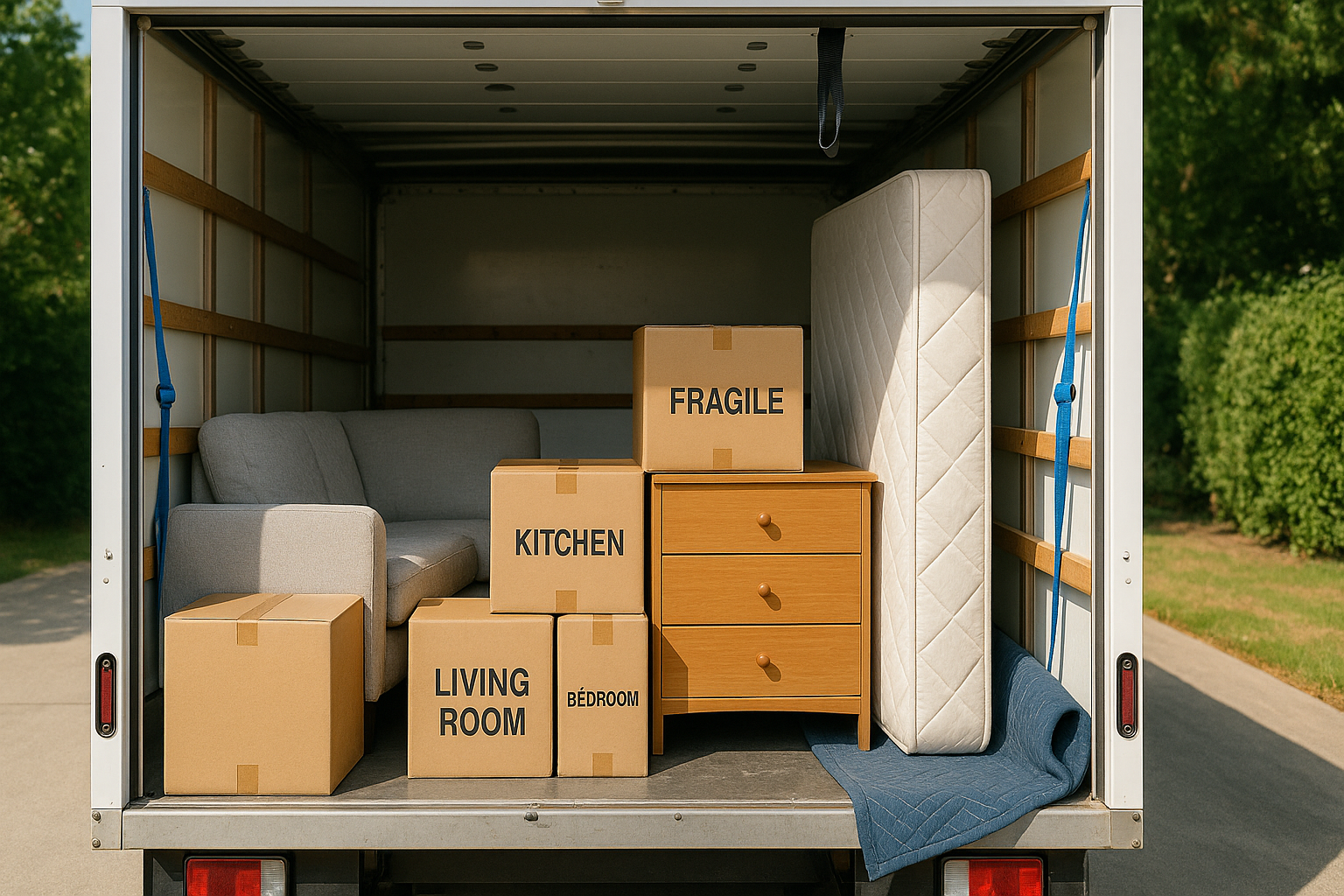Moving a hot tub safely requires proper equipment, enough helpers, and careful planning to avoid injury or damage. Most hot tubs weigh between 500 and 1,200 pounds when empty and measure 7 to 8 feet square, making them a challenging task for DIY movers. Discover the equipment requirements, step-by-step moving instructions, cost comparisons between DIY and professional services, and safety protocols you need to know to protect your investment and health during your next move.
⚠️ Safety Warning: Moving a hot tub involves significant risk of personal injury and property damage due to the extreme weight and awkward dimensions of these units. Always prioritize safety by using proper equipment, having adequate help, and considering professional movers if you have any doubts about your ability to complete the move safely.
How to Move a Hot Tub Step-by-Step
Most moving guides don't prepare you for real challenges like a hot tub corner catching on a doorframe or dolly wheels sinking into soft ground. Recognizing and adjusting to these scenarios quickly is the difference between a successful move and costly damage.
Before You Start the Hot Tub Moving Process
Start planning your hot tub move several weeks in advance to ensure you have enough time to handle all necessary preparations. Before you begin, measure every doorway, gate, and path the hot tub will travel through. Most hot tubs measure 7 to 8 feet square and 3 to 4 feet tall, requiring at least 8 feet of clearance width to move safely. Document obstacles like low-hanging branches, garden features, and stairs that could complicate the route.
Call your local building department about permits for street closures or sidewalk use, as many cities require permits when moving large items across public property. Your homeowner's association might also have specific rules about moving times and equipment placement. Handle these requirements early to avoid delays or fines on moving day.
Read your hot tub warranty carefully before you start. Some manufacturers require certified technicians to disconnect and reconnect units to keep your warranty valid. Take photos of your hot tub's condition, noting any existing damage or wear, and review our guide on important questions to ask moving companies about their experience with specialty items.
Step 1: Disconnect Power and Electrical Components
Safety is paramount when moving a hot tub. Begin by disconnecting power at the main electrical panel, not just the spa's control panel. Water and electricity create deadly combinations, so never skip this step. If you're uncomfortable working with 240-volt connections, hire a licensed electrician to handle the disconnection safely.
Professional electricians offer several advantages for hot tub relocation:
- Electricians safely disconnect the spa's 240-volt power supply, eliminating electrocution risks.
- Pre-wiring services at your new location cost $200 to $500 and ensure code compliance.
- Professional electrical work protects both your safety and your hot tub's warranty coverage.
- Licensed electricians arrange required inspections, streamlining the setup process.
Step 2: Drain Your Hot Tub Completely
Complete drainage is essential before moving your hot tub. Use the built-in drain valve or a submersible pump to remove all water. A standard hot tub holds 300 to 500 gallons, taking 2 to 4 hours to empty through gravity drainage. Submersible pumps reduce this to under an hour, making them worth the rental cost for time-sensitive moves.
When draining your hot tub, follow these water disposal guidelines:
- Direct water into storm drains or designated drainage areas approved by local codes.
- Spread water across your lawn only after letting chlorine dissipate for 48 hours to protect grass.
- Check with your municipality about water discharge regulations for pool and spa drainage.
- Never drain hot tub water near septic systems or vegetable gardens due to chemical content.
Step 3: Prepare the Hot Tub by Removing Detachable Components
Before moving, prepare the hot tub by removing all parts you can take off to reduce weight and prevent damage during transport:
- Remove the cover, steps, and side panels if your model allows easy detachment.
- Store filters, headrests, and control panels separately in labeled boxes to prevent damage.
- Clean and dry the shell thoroughly, as remaining water adds significant weight to the move.
- Blow out plumbing lines using a shop vacuum to remove all water completely.
- Even small amounts of water sloshing during moves can crack shells or damage internal pumps.
- Wrap detached components in moving blankets and transport them separately from the main unit.
Step 4: Position and Load the Hot Tub onto Moving Equipment
Once your hot tub is ready, position your moving team around it with at least one person on each side. Lift one side carefully, sliding the first dolly underneath at the center balance point. Lower that side gently, then repeat for the opposite side to distribute weight evenly.
Some people prefer tipping the hot tub onto its side for rolling on a spa sled, but never rest it on the equipment side, where pumps and heaters sit. This can cause permanent damage to expensive mechanical components.
Step 5: Transport the Hot Tub with Proper Team Coordination
During the move, maintain slow, deliberate movements and communicate constantly with your team. One person should direct movement while others focus on lifting and balancing. Follow these critical movement guidelines to prevent injury and damage:
- Take breaks every 15 to 20 feet to rest and reassess your grip, preventing fatigue-related accidents.
- Navigate corners by pivoting gradually rather than sharp turns that stress the hot tub structure.
- Use your wooden boards to create smooth pathways over grass, gravel, or steps for stable rolling.
- Maintain consistent speed and avoid sudden stops that can shift the hot tub's center of gravity.
- Assign a spotter to watch for obstacles and guide the team around tight spaces safely.
Understanding realistic moving timelines helps you plan enough time for this careful process without rushing through critical safety steps.
Step 6: Load and Secure the Hot Tub in Your Moving Truck
Loading onto your truck requires coordinated effort and proper positioning. Use the truck's ramp to roll the hot tub inside, securing it right away with ratchet straps rated for the weight. Position the hot tub against the truck's front wall, using moving blankets to prevent sliding during transport.
Follow these truck loading and transport best practices:
- Use multiple ratchet straps (at least four) attached to secure truck anchor points on both sides.
- Check strap tension after the first mile of driving and tighten if needed to prevent shifting.
- Drive slowly to your destination, avoiding sudden stops or sharp turns that stress the unit.
- Place additional moving blankets between the hot tub and truck walls to absorb vibration.
- Keep speed under 45 mph and add extra following distance for gradual braking.
Hot Tub Moving Equipment and Supplies Checklist
Having the right equipment makes hot tub moving safer and easier. You'll need the right tools to protect yourself and your hot tub during the move. Moving Equipment You'll Need:
- Four-wheeled furniture dollies rated for 1,000 pounds or more for stable transport across flat surfaces.
- At least two dollies for most moves, plus backup equipment in case of failure.
- Lifting straps to distribute weight across your body and reduce strain on your back and arms.
- Moving blankets and padding to protect the hot tub shell from scratches and dents.
- Heavy-duty tape or shrink wrap to secure blankets in place.
- 4x4 wooden boards or thick plywood sheets to protect lawns and provide stable surfaces for dollies.
These boards also help bridge uneven ground or small steps, making the move smoother and safer.
Hot Tub Moving Equipment Rental Costs for DIY Moves:
Total equipment rental costs range from $150 to $400 for a DIY move. Professional spa sleds cost more but make the job much easier. Understanding typical moving costs helps you budget for equipment versus professional services.
- Dollies: $40 to $60 per day.
- Lifting straps: $30 to $50.
- Moving truck with loading ramp: $100 to $200 daily for local moves.
- Professional spa sleds (designed specifically for hot tub transport): $75 to $150.
Should You DIY Your Hot Tub Move?
Before tackling the physical challenge of moving your hot tub, consider whether relocation makes financial sense. A working hot tub adds $5,000 to $15,000 in home value, but moving costs can reach $1,200 or more for professional services.
The age and condition of your hot tub should guide your decision:
- Hot tubs less than five years old and in good condition typically cost less to move than buying new.
- Models over ten years old often have outdated pumps, heaters, and jets that cost thousands to replace.
- Some manufacturers void warranty coverage if you move the unit yourself or use non-certified movers.
Distance plays a crucial role in the financial equation. Moves under 50 miles usually make sense for quality hot tubs, whether you do it yourself or hire local movers.
Long-distance relocations present different challenges:
- Costs can double or triple due to specialized transport requirements.
- Crane services may be needed at both locations.
- For moves over 200 miles, selling your current tub and buying new at your destination often saves money.
DIY vs. Hiring Professional Movers for a Hot Tub
Moving a hot tub yourself is possible with the right team and equipment, but the risks are real. You'll need at least four to six strong adults who can lift heavy loads safely.
Consider the physical demands carefully:
- The average person can safely lift 50 to 75 pounds repeatedly.
- Your team shares the weight of a 900-pound hot tub at 150 to 225 pounds per person.
- Awkward angles, stairs, and tight spaces add significant difficulty beyond raw weight.
Professional movers bring experience, proper equipment, and insurance coverage. They know how to transport a hot tub without damaging the shell, plumbing, or electrical components.
Full-service moving companies charge $400 to $1,200 for local hot tub moves. The price varies based on access difficulty, distance, and hot tub size.
A smart middle option exists for budget-conscious homeowners. Movers who offer loading and unloading services let you rent the truck while professionals handle the heavy lifting.
This approach offers several advantages:
- Companies provide vetted, experienced movers who know proper lifting techniques.
- Professional movers have the right equipment for safe transport.
- Costs typically run 40 to 50 percent less than full-service movers.
- You eliminate injury risk and damage concerns while maintaining budget control.
When weighing DIY versus professional moving help, this model offers over 30% savings and the expertise of professionals, while giving you control of your move.
Cost Breakdown: DIY vs. Professional
DIY hot tub moving costs between $150 and $400 for equipment rental and supplies, assuming you have willing helpers and a suitable vehicle. Add truck rental if needed, bringing total DIY costs to $250 to $600.
However, the real cost extends beyond equipment:
- Your time investment typically runs 6 to 10 hours for a complete move.
- Injury risk could mean missed work days or medical bills that dwarf equipment savings.
- Potential damage to your hot tub may require expensive repairs or replacement.
Professional moving companies charge $400 to $1,200 for standard local moves. Complex moves involving stairs, cranes, or long carries can reach $2,500. Most companies complete hot tub moves in 2 to 4 hours, minimizing disruption to your day.
Professional services include:
- Experienced labor trained in proper lifting techniques.
- All necessary equipment for safe transport.
- Transportation with appropriate vehicles and securing methods.
- Basic insurance coverage protecting against damage or injury.
Labor-only services offer significant savings for those comfortable driving the truck themselves. Professional movers charge $50 per mover per hour, with most hot tub moves requiring two to four movers for two to three hours.
This hybrid approach delivers:
- Total costs ranging from $200 to $600.
- Savings of hundreds compared to full-service options.
- Experienced help with the dangerous lifting work.
- Control over your moving timeline and truck rental choices.
Common Hot Tub Moving Mistakes and How to Avoid Them
Don't try to move a hot tub without enough help. Three people might seem like enough, but you'll get tired fast when moving 900 pounds. You need someone to guide and watch while others lift, so four people is the minimum for safety.
The most common mistakes that cause damage or injury are:
- Using too few people to save money, which often results in expensive damage or injuries.
- Forgetting to secure the hot tub properly during transport with multiple ratchet straps.
- Failing to check straps after the first mile of driving and tighten if needed.
- Placing hot tubs on unprepared or uneven surfaces that aren't completely level.
If hot tubs slide even a few inches during transport, they can crack shells or break plumbing connections. Always use multiple ratchet straps attached to secure truck anchor points.
Your new location needs a completely level, reinforced surface that can support 6,000 pounds when filled. Concrete pads work best, while reinforced decks need engineering approval. Setting a hot tub on uneven ground causes stress cracks and equipment failure.
If you're moving to your first home, talk with professionals about proper hot tub placement before installation.
Post-Move Setup and Maintenance
Set your hot tub on its prepared base, making sure it sits completely level. Even small tilts affect water circulation and jet performance. Use a long level to check multiple directions, adding shims if needed. Let the hot tub settle for 24 hours before making final adjustments.
Reconnect electrical service using a licensed electrician for safety and code compliance. They'll verify proper grounding, install required GFCI protection, and test all connections. Most areas require inspection of hot tub electrical work, which your electrician typically arranges. Budget $300 to $800 for professional electrical reconnection.
Fill your hot tub slowly through the filter compartment to prevent airlocks in the plumbing. Run the pumps briefly every few inches of fill to purge air from lines. Once full, balance the water chemistry before heating. Test all jets, lights, and controls to verify everything survived the move intact.
Moving a Hot Tub On Your Own: Is It Worth It?
Moving a hot tub successfully requires careful planning, proper equipment, and adequate help. While DIY saves money, the injury and damage risks make professional assistance worth considering. The smartest approach combines renting your own truck with hiring professional labor for the heavy lifting.
Choose professional movers for stairs, tight spaces, or valuable hot tubs. If going DIY, never compromise on safety equipment or adequate helpers (the savings aren't worth injuries or damage). Hybrid moving services offer the ideal balance: you handle transportation while professionals manage the dangerous work, delivering professional quality at $50 per mover per hour with transparent pricing.
Frequently Asked Questions on Moving Hot Tubs
How much does it cost to move a hot tub myself?DIY moves cost $150 to $400 for equipment rental, or $250 to $600 if you need to rent a truck.
Can you move a hot tub on its side?Yes, but only rest it on the side opposite the equipment panel to avoid damaging pumps and heaters.
Will moving void my hot tub warranty?Some manufacturers void warranties for owner-performed moves. Check your specific warranty terms before proceeding.
How long does it take to drain a hot tub before moving?Gravity drainage takes 2 to 4 hours, while submersible pumps reduce this to under an hour.
Do I need a permit to move a hot tub?Many cities require permits for moving large items across public property or sidewalks. Check with your local building department.










































